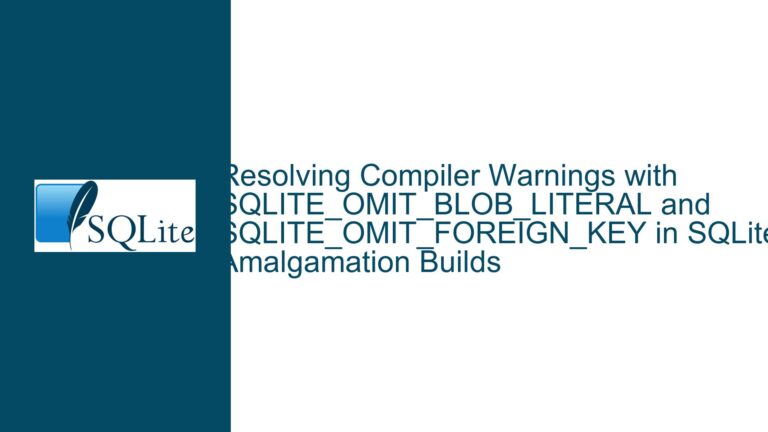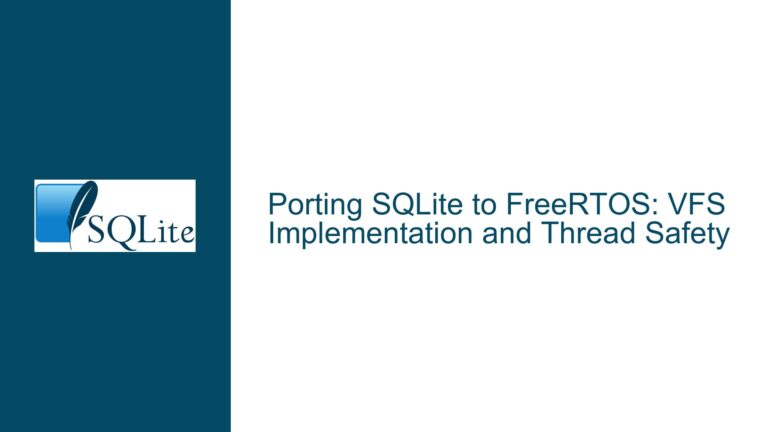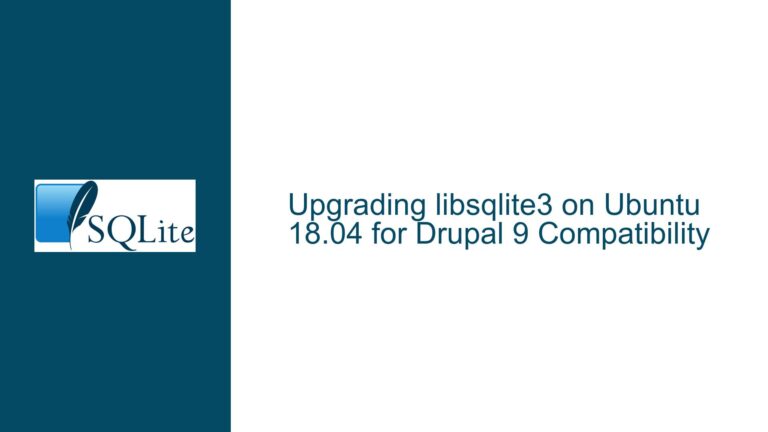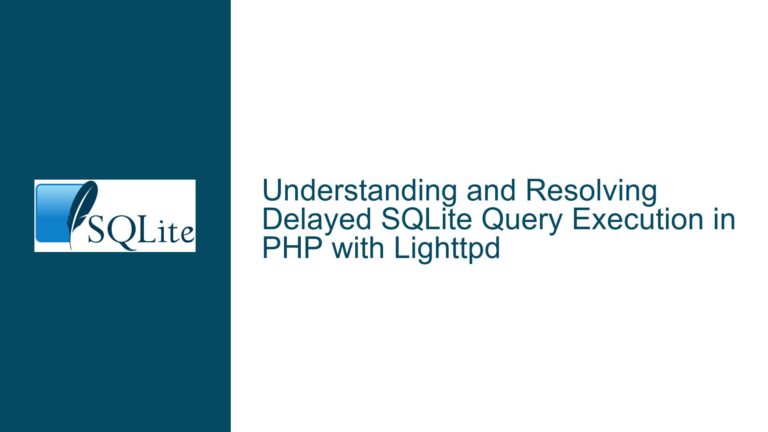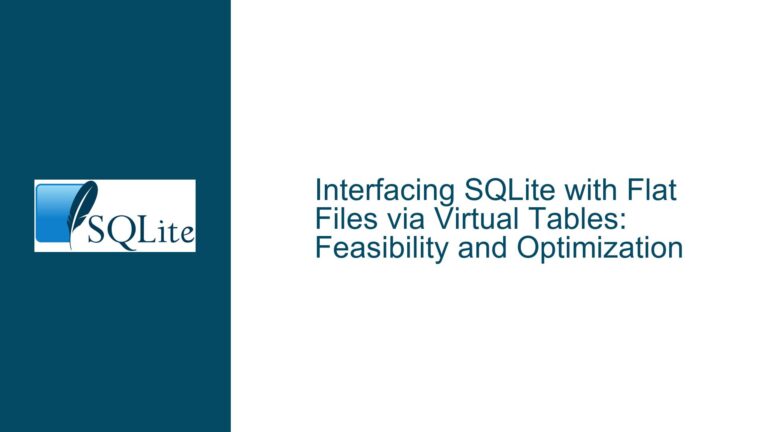SQLite sqldiff Tool and Column Removal: Why ALTER TABLE DROP COLUMN Is Not Used
Understanding SQLite’s sqldiff Behavior with Column Removal
The core issue revolves around the behavior of SQLite’s sqldiff tool when comparing two databases where one database has a table with an additional column compared to the other. Instead of generating an ALTER TABLE DROP COLUMN statement to remove the extra column, sqldiff opts for a more drastic approach: it drops the entire table and recreates it without the extra column. This behavior raises questions about the tool’s design, its alignment with SQLite’s evolving features, and its suitability for schema migration tasks.
To fully grasp the issue, it is essential to understand the context in which sqldiff operates. SQLite introduced support for ALTER TABLE DROP COLUMN in version 3.35.0, released in March 2021. This feature allows for the removal of columns from a table without requiring the table to be dropped and recreated. However, sqldiff, despite being a tool designed to compare databases, does not leverage this feature. Instead, it defaults to a destructive approach that involves dropping and recreating tables.
This behavior is not inherently wrong but reflects the tool’s intended purpose. sqldiff is primarily designed to highlight differences in data between two databases, particularly for tables that have rowids. It is not explicitly designed as a schema migration tool, and its output is optimized for simplicity and reliability rather than minimizing disruption to the database structure.
The discrepancy between the availability of ALTER TABLE DROP COLUMN and its absence in sqldiff‘s output can be attributed to several factors. First, sqldiff was developed before the introduction of ALTER TABLE DROP COLUMN, and its behavior has not been updated to incorporate this feature. Second, the tool’s primary focus on data differences rather than schema differences means that schema changes are handled in a way that ensures consistency, even if it involves more drastic measures like dropping and recreating tables.
Understanding this behavior requires a deeper dive into the technical and philosophical underpinnings of sqldiff and SQLite itself. SQLite is renowned for its lightweight, embedded nature, and its tools are designed to be simple and reliable. sqldiff adheres to this philosophy by providing a straightforward way to compare databases, even if it means sacrificing some finesse in handling schema changes.
Why sqldiff Does Not Use ALTER TABLE DROP COLUMN
The absence of ALTER TABLE DROP COLUMN in sqldiff‘s output can be attributed to several key factors. These factors include the tool’s historical development, its intended purpose, and the broader context of SQLite’s design philosophy.
Historical Context and Feature Availability
SQLite’s support for ALTER TABLE DROP COLUMN is a relatively recent addition, introduced in version 3.35.0. Prior to this, the only way to remove a column from a table was to create a new table without the column, copy the data over, and drop the old table. This approach, while cumbersome, was necessary due to SQLite’s design constraints.
sqldiff predates the introduction of ALTER TABLE DROP COLUMN and was designed to work with the features available at the time. Its behavior of dropping and recreating tables reflects the limitations of earlier SQLite versions. While the tool could theoretically be updated to use the new feature, doing so would require significant changes to its codebase and testing to ensure compatibility with older versions of SQLite.
Purpose and Scope of sqldiff
sqldiff is not a schema migration tool. Its primary purpose is to compare the data in two databases and generate SQL statements that reflect the differences. This focus on data rather than schema means that sqldiff is optimized for simplicity and reliability, even if it results in more disruptive changes to the database structure.
When sqldiff encounters a schema mismatch, such as a table with an extra column, it prioritizes consistency over elegance. Dropping and recreating the table ensures that the resulting schema matches the target database exactly, without relying on potentially complex or error-prone schema migration logic.
SQLite’s Design Philosophy
SQLite is designed to be lightweight, embedded, and easy to use. Its tools, including sqldiff, reflect this philosophy by prioritizing simplicity and reliability over advanced features. While ALTER TABLE DROP COLUMN is a powerful feature, its inclusion in sqldiff would add complexity to the tool and potentially introduce new edge cases and bugs.
Moreover, SQLite’s tools are often developed as utilities rather than core components of the database engine. This means that they may not always be updated to take advantage of new features, especially if those features fall outside the tool’s primary scope.
Practical Considerations
From a practical standpoint, updating sqldiff to use ALTER TABLE DROP COLUMN would require significant effort. The tool would need to be modified to detect schema differences and generate the appropriate SQL statements. This would involve not only coding changes but also extensive testing to ensure that the tool works correctly in all scenarios.
Given that sqldiff is not a schema migration tool, the benefits of such an update may not justify the effort required. Users who need advanced schema migration capabilities are better served by dedicated tools or custom scripts that leverage SQLite’s full range of features.
Addressing the Issue: Alternatives and Best Practices
While sqldiff does not currently use ALTER TABLE DROP COLUMN, there are several ways to address the issue and achieve the desired outcome. These include using alternative tools, writing custom scripts, and adopting best practices for schema migration.
Using Alternative Tools
For users who require more advanced schema migration capabilities, alternative tools may be a better fit than sqldiff. These tools are specifically designed to handle schema changes and can leverage SQLite’s full range of features, including ALTER TABLE DROP COLUMN.
One such tool is alembic, a database migration tool for SQLAlchemy that supports SQLite. alembic can generate and execute migration scripts that include ALTER TABLE DROP COLUMN statements, making it a powerful alternative to sqldiff for schema migration tasks.
Another option is to use a custom script that compares the schemas of two databases and generates the appropriate SQL statements. This approach provides maximum flexibility and allows users to tailor the migration process to their specific needs.
Writing Custom Scripts
For users who prefer a more hands-on approach, writing a custom script to handle schema migration is a viable option. This script can compare the schemas of two databases and generate ALTER TABLE DROP COLUMN statements as needed.
The script can be written in any programming language that supports SQLite, such as Python, Ruby, or JavaScript. It would typically involve the following steps:
- Connect to both databases and retrieve their schemas.
- Compare the schemas to identify differences, such as extra columns.
- Generate and execute
ALTER TABLE DROP COLUMNstatements for each extra column.
This approach requires some programming knowledge but provides complete control over the migration process.
Best Practices for Schema Migration
Regardless of the tools or scripts used, adopting best practices for schema migration can help ensure a smooth and reliable process. These best practices include:
- Backup the Database: Before making any changes, create a backup of the database to protect against data loss.
- Test the Migration: Perform the migration on a test database to identify and resolve any issues before applying it to the production database.
- Use Transactions: Wrap the migration in a transaction to ensure that all changes are applied atomically. If any part of the migration fails, the transaction can be rolled back to restore the database to its original state.
- Document the Changes: Keep a record of all schema changes, including the SQL statements used and the reasons for the changes. This documentation can be invaluable for troubleshooting and auditing purposes.
By following these best practices, users can minimize the risks associated with schema migration and ensure that their databases remain consistent and reliable.
Future Updates to sqldiff
While sqldiff does not currently use ALTER TABLE DROP COLUMN, it is possible that future updates to the tool may incorporate this feature. However, given the tool’s primary focus on data differences rather than schema differences, such an update is unlikely to be a high priority.
Users who require this functionality are encouraged to explore alternative tools or write custom scripts to meet their needs. In the meantime, understanding the limitations of sqldiff and adopting best practices for schema migration can help mitigate the impact of its current behavior.
In conclusion, the behavior of sqldiff when handling column removal reflects its historical development, intended purpose, and alignment with SQLite’s design philosophy. While the tool does not currently use ALTER TABLE DROP COLUMN, alternative tools, custom scripts, and best practices can help users achieve their desired outcomes. By understanding the underlying issues and exploring these options, users can effectively manage schema changes in SQLite databases.

